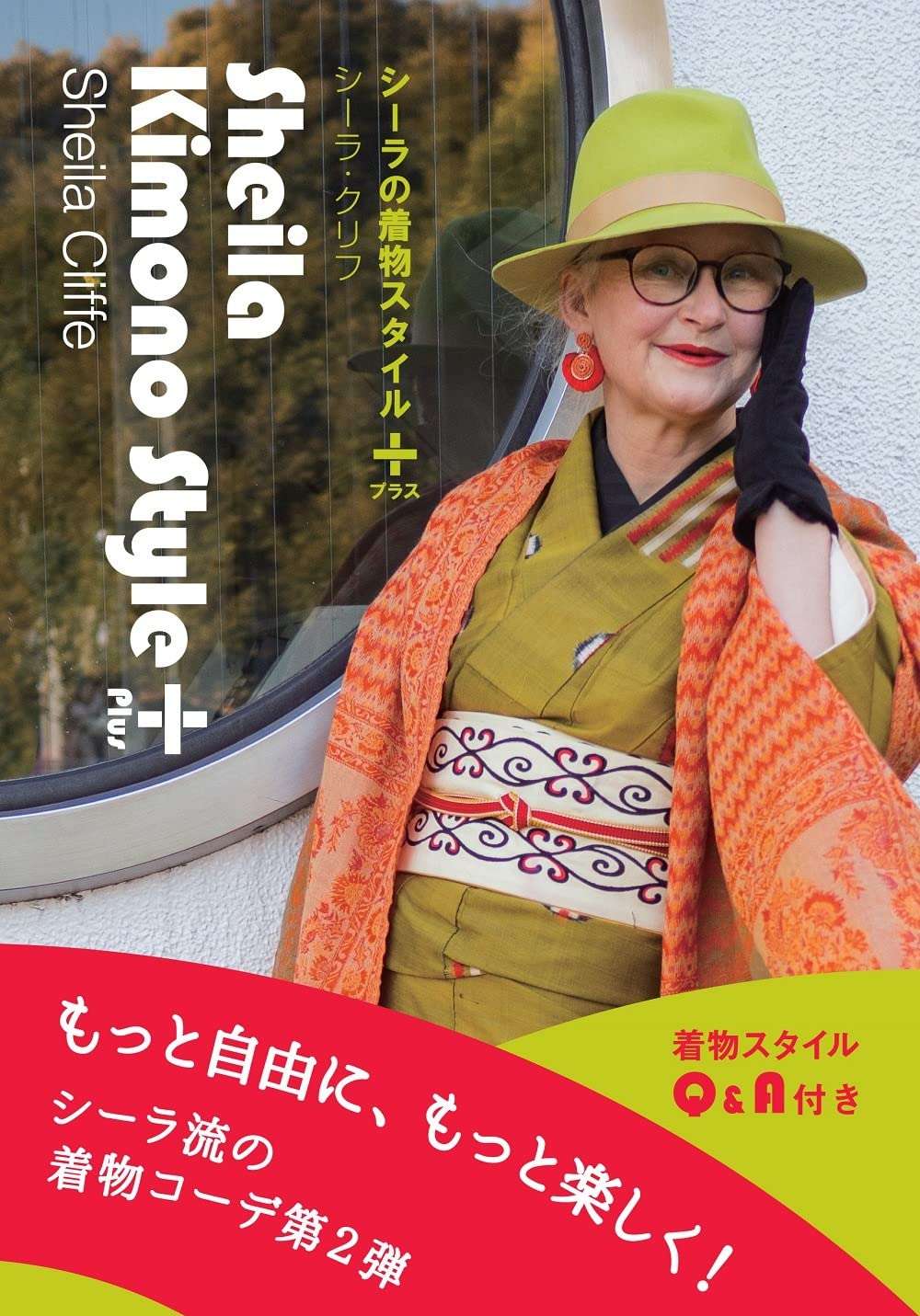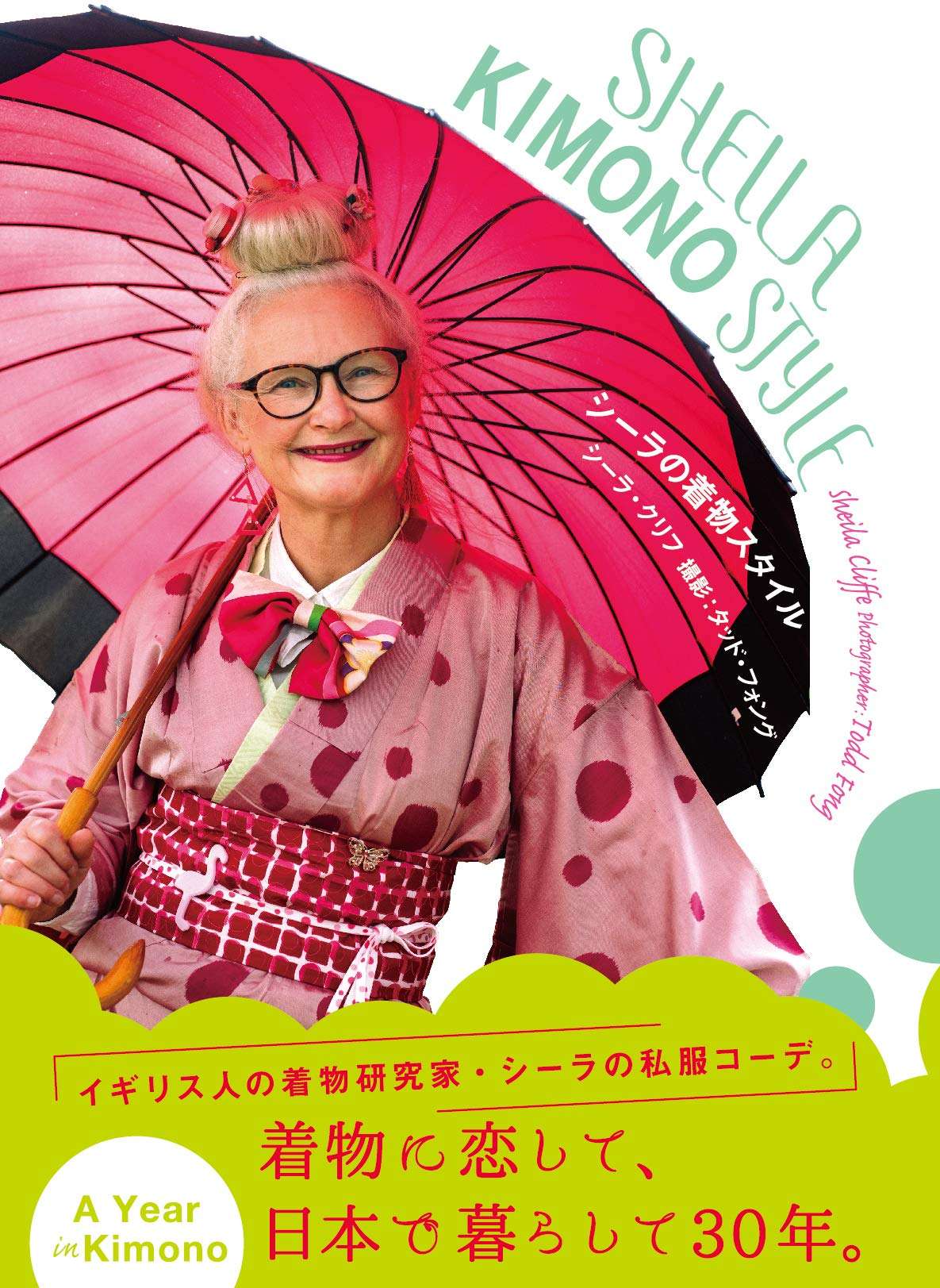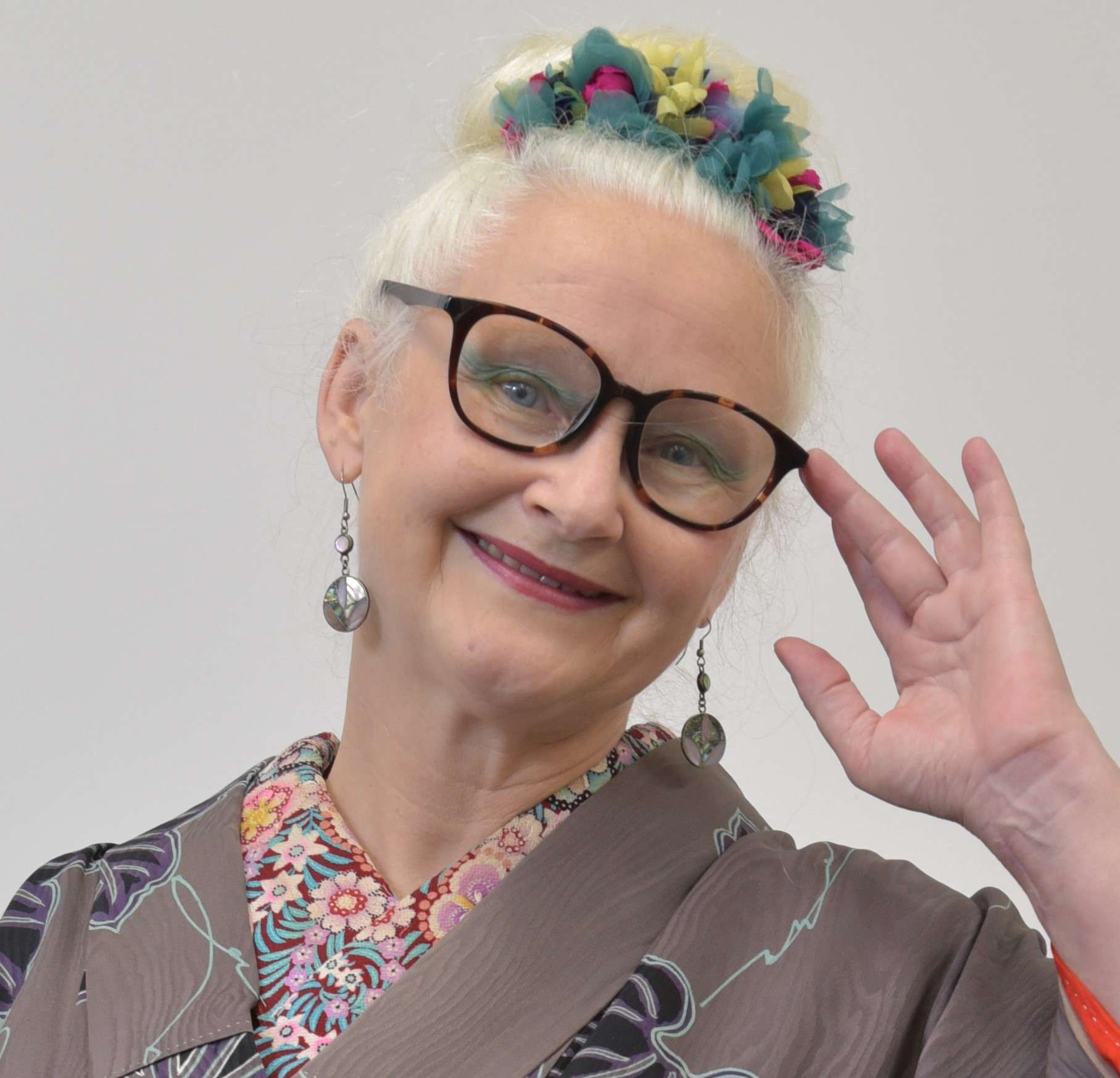
イギリス人着物研究家、シーラ・クリフさんのインタビューを全2回でお届けします。前編では、シーラさんの忘れられない着物との出合いや、なかなか語られない日本の服飾史などについてお話をお伺いします。英語音声も併せてお楽しみください。
※本記事は『ENGLISH JOURNAL』2022年9月号に掲載された内容を再編集したものです。
シーラ・クリフさんってどんな人?
シーラ・クリフさんは、イギリス出身の着物研究家です。日本で暮らして約35年になるクリフさんは、大学で英語と着物文化を教えながら、着物の魅力を国内外に広める活動をしています。また、おしゃれ且つ個性的な着物の着こなしでSNSでのフォロワーも多く、着物インフルエンサーとしてテレビ番組やCM、雑誌などでも活動しています。その数々のすてきな着こなしは、ぜひシーラさんのInstagramでご覧ください。
魅惑的な着物との出合い
――24歳で初めて来日した際に着物に出合ったとお伺いしましたが、そのときのことを覚えていますか?
当時は古い陶器に興味があって、古い食器をたくさん扱う神社ののみの市に通っていました。いつものように食器を眺めていると、ふとある物が目に留まり、「あそこのハンガーに掛かっているのはなんだろう?すごく奇麗でカラフルだわ」と思いました。当時はそれが「着物」と呼ばれていることすら知りませんでした。
着物の色とりどりの鮮やかな色彩に引かれたのです。生地はとても柔らかくて光沢があり、美しい模様が描かれていました。織り模様や染め模様もありました。まるで布に絵を描いているかのように思えて、とにかくとても美しく、手触りが柔らかかったことを覚えています。特に、染められた布では今までに見たこともないような、深い赤色に魅了されました。英語ではどう表現したらいいのか分からないのですが、赤の中の赤というか。信じられないくらい赤色に深みがあって、それがとても魅力的に感じました。
そして赤い無地のものを購入しました。それを家に持ち帰って友達に「のみの市で着物を買ったのよ」と話して見せたら、彼女たちは「それは着物じゃなくて下着(長じゅばん)よ!」と言うんです。私は「え?信じられないくらい奇麗なのに、どうしてこれが下着なの?なんでこれを隠してしまうの?」と思いました。そのときがなんというか、これはとてつもなく私が興味を持てるものになりそうだなと気付いた瞬間でした。
私はちょっとしたトレンド・ハンターだったものですから、あちこちの本屋や呉服屋を回るようになりました。当時、日本語はあまり話せませんでしたし読むことも全然できなかったので、写真を見るためだけに雑誌を買っていました。呉服屋の店員は一生懸命に私に着物を売ろうとして、ほとんど何も理解できない私に寄ってきてたくさんのことを説明してくれました。そうやって本屋や呉服屋を巡って、たくさんのことを学びました。
記録されていないファッション史
――着物という自分たちの伝統について日本人がほとんど知らないのは、なぜだと思いますか?
日本の服飾史は、「着物、着物、着物」と一本の流れで来て、それが突然洋服に変わる、という感じで書かれているように思います。でも、私はそうではないと思うんです。「着物、着物、着物」と来て、明治時代にもう一本の流れ(洋服)が始まったんだと思います。着物の流れは終わらず、着物と洋服という二つの系統が一緒に続いていくんです。
洋服を最初に着た人たちは、現代のファッションの普及の仕方と違って、通常のファッションの普及の最後尾にいる人たちでした。つまり、政府関係者などの年配の男性が最初に洋服を着て、それから行政階級、そして軍人や郵便局員、こういった人たちが制服として洋服を着るようになります。これは日本が西欧諸国に加わるという、政治的姿勢なのです。そして明治時代には、女性も少しその流れに加わりました。しかし第2次世界大戦に至るまでは、ほとんどの日本人女性は着物を着ていました。洋服は存在しましたが、着物の流れは途絶えていなかったのです。
ところが戦後の占領下になると、実用的だという理由で洋服が日本人に受け入れられようになります。洋服を着る学生世代が成長し、戦後にその親が洋服を着るようになって、そうして初めて、一つの世代が着物ではなく洋服で育ちました。戦前は皆、着物で育っていたのに。そして、母親が娘たちに着付けを教える流れ、つまり母親が娘たちに着物を着せて、娘たちが自分で着られるようになる流れが途絶えてしまいます。
ただ、洋服が人の心を引き付けられたのは、実用面だけでした。ファッション性では引き付けられなかったのです。一方着物は引き続き、ファッションそのものでした。1930年代から40年代を通じて、ファッション性の高い着物が新しくたくさん出てきました。50年代にはファッションイラストレーターの中原淳一さんが、洋服ファッションの美しいイラストを描きましたが、すてきな着物ファッションのイラストも描き続けていました。それらの着物は戦前のものと違って洋服の影響を受け、より実用的になり、デザインの季節感は薄れて一年中着られ、大きくて大胆な幾何学模様があったり、袖は短めで白い襟が付いたりしたものでした。
その後も着物ファッションはさらに進化し、変化していきました。ところが、普段着が洋服に取って代わられたことで、着物は日常生活から切り離された特別なものとなり、祭事だけに着るものと思われるようになりました。言ってみれば、上流中産階級のものになったんです。
インタビュー後編は3月14日(火)公開予定です。後編では着物の柄や生地の最新トレンド、着物を着てみたいけどなかなか一歩を踏み出せない人へのアドバイスなどをお伺いします。お楽しみに!
インタビュー音声と英語スクリプト
実際のインタビュー音声を聞いてみましょう。シーラさんの話す英語は、イギリス英語。語尾のtやdの音の強調が目立つのが特徴です。ゆっくりでとても丁寧な話し方なので、聞き取りやすいでしょう。英語スクリプトもご参考ください。
――You discovered kimono on your first trip to Japan, at the age of 24. Do you remember how it felt to see a kimono for the first time?
So, at that time, I was kind of interested in old pottery. And so, I was going to shrine flea markets where you can find lots of old dishes. And I always started out looking at dishes. And then I would just look, “What’s that over there hanging up on those hangers? They’re[It’s] so beautiful and colourful.” I didn’t even know it was called kimono. I didn’t know anything about what it was.
And I was just attracted to the huge range of bright colours. And the fabric was so soft and shiny. And there were beautiful patterns on so many of the garments — woven patterns and also dyed patterns. It looked like painting on cloth. And it was so, just beautiful, and soft to touch. And I was really attracted to the red in particular, because it was like the deepest red I’ve ever seen on cloth, dyed on cloth. (It) Was like a red red, ha-ha — I don’t know how to describe it in English — but just so incredibly red and deep. And I was really attracted to that.
And I bought one of the plain red ones, thinking it was a kimono. And I took it home and I told a friend, “Oh, I bought a kimono at a flea market the other day.” And they said, “Oh, show me.” I showed them. They’re like, “That’s not a kimono. That’s underwear!” And I’m like, “What? And it’s so incredibly beautiful. It’s so amazingly beautiful. How could that be underwear? How can you cover it up?” Ha-ha. And that was kind of, I don’t know, some kind of moment where I realised that this thing was just gonna be so fascinating.
And I started to — I was a bit of a trend hunter — I just started to trawl through bookshops and kimono shops. I couldn’t really speak much Japanese then. And I certainly couldn’t read, but I bought the magazines anyway, just to look at the pictures. And at that time, the staff in kimono stores were really doing a hard sell. And they would come up and explain so much to me even though I could understand almost nothing. But I learnt a lot, in the end, through those trips to the bookstores and kimono stores.
――Why do you think Japanese people today generally know very little about their own heritage in regard to kimono?
Well, I think people write history of clothing in Japan as like, “Kimono, kimono, kimono,” one line, and then suddenly it changes to Western dress. And it’s just one line. But I don’t think that’s true, I don’t think that’s what happened. I think it’s, “Kimono, kimono, kimono, kimono,” and another line starts in the Meiji period. But the kimono line doesn’t stop, and those two systems go on together.
But unlike (the) usual diffusion of fashion, the first wearers of Western dress are the people who are usually last in the diffusion of fashion. So, elderly men wear Western clothing, the government and then the administrative class and soldiers and the post office workers, and these people go into uniforms — which is a political stance to join Western nations. And women played with it for a little while in the Meiji period. But up, then up to the Second World War, most Japanese women were still wearing kimono. Western clothing was there, but the kimono line has not stopped.
But then, after the war, during the occupation, Western clothing is sold to Japanese people as being practical. And so, a generation grows up where schoolchildren have worn Western clothes, and their parents start to wear Western dress after the war. And a generation grows up in Western dress for the first time. Whereas prewar, people grew up in kimono. So, the natural line of (a) mother teaching their daughter to dress, just dressing them, and then them dressing themselves, is broken.
But the only vector that Western dress could win on was practicality. It couldn’t win on fashionability. Kimono still embodied fashion. And right through the ’30s and ’40s, there were lots of new fashionable kimono. And then in the ’50s as well, Nakahara Junichi the fashion illustrator, he did beautiful fashion illustrations of Western dress but still lovely fashion illustrations of kimono as well. And it was different from kimono before the war — it was influenced by Western dress, was more practical, less emphasis on the seasons in the designs on the kimono, big bold geometric patterns that you could wear at any time of the year, and shorter sleeves, white collars.
Kimono fashion was still evolving and changing and going on. But as everyday dress had lost out to Western dress, it became too special and separate from everyday life, and people began to think of it as only for ceremonies. So, it became kind of upper middle class, if you like.
シーラさんのスタイルブックもおすすめ
取材:知夏七未 写真:安宅雅美(編集部)









